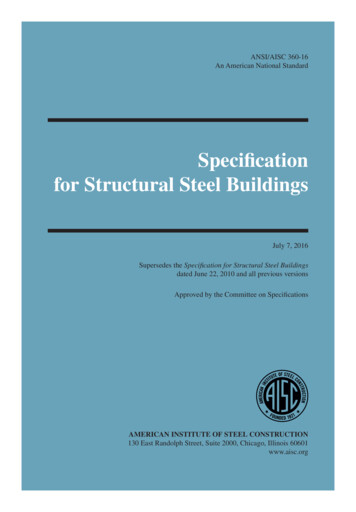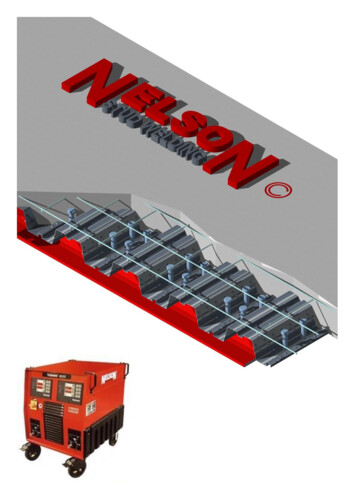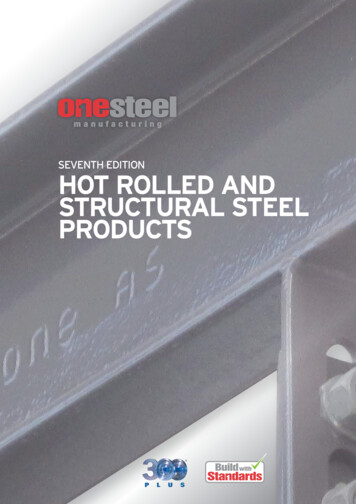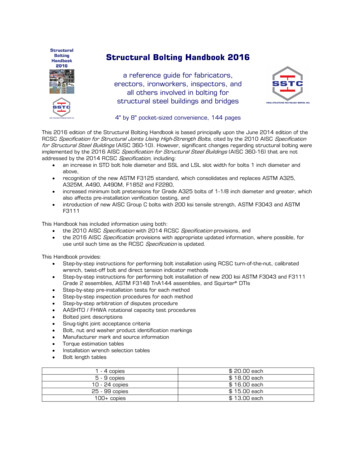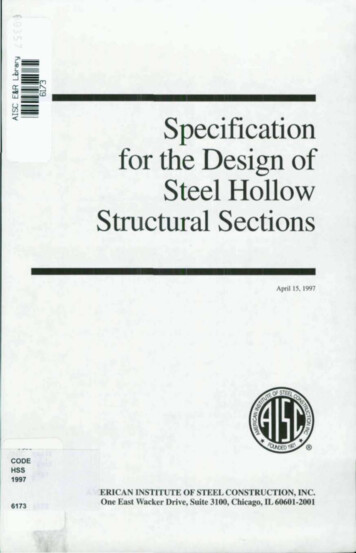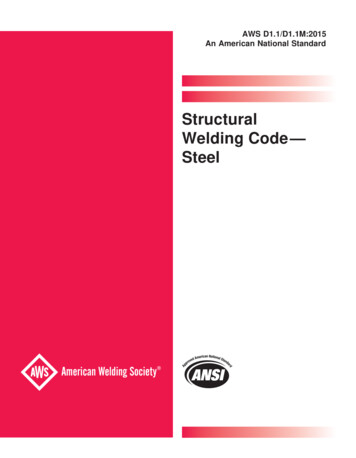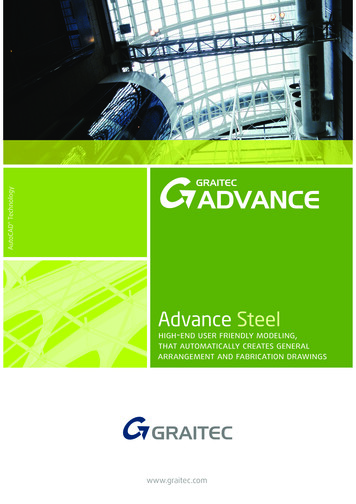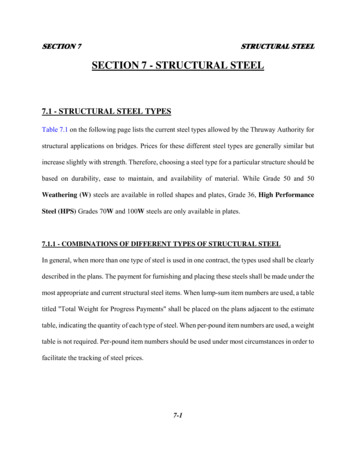
Transcription
SECTION 7STRUCTURAL STEELSECTION 7 - STRUCTURAL STEEL7.1 - STRUCTURAL STEEL TYPESTable 7.1 on the following page lists the current steel types allowed by the Thruway Authority forstructural applications on bridges. Prices for these different steel types are generally similar butincrease slightly with strength. Therefore, choosing a steel type for a particular structure should bebased on durability, ease to maintain, and availability of material. While Grade 50 and 50Weathering (W) steels are available in rolled shapes and plates, Grade 36, High PerformanceSteel (HPS) Grades 70W and 100W steels are only available in plates.7.1.1 - COMBINATIONS OF DIFFERENT TYPES OF STRUCTURAL STEELIn general, when more than one type of steel is used in one contract, the types used shall be clearlydescribed in the plans. The payment for furnishing and placing these steels shall be made under themost appropriate and current structural steel items. When lump-sum item numbers are used, a tabletitled "Total Weight for Progress Payments" shall be placed on the plans adjacent to the estimatetable, indicating the quantity of each type of steel. When per-pound item numbers are used, a weighttable is not required. Per-pound item numbers should be used under most circumstances in order tofacilitate the tracking of steel prices.7-1
SECTION 7STRUCTURAL STEELSTEEL SPECIFICATION TABLEASTM A709&AASHTO 505070100MIN.TENSILEFu(ksi)58657085110TABLE 7.1***Thermo-Mechanical Control Process (TMCP) Steel is a newer version ofHPS70W that is not quenched and tempered.It is preferred over HPS70W steel when available.This steel shall only be used with approval from the DSD.7.2 - MINIMUM THICKNESS OF METALStructural steel (including lateral bracing, cross frames, diaphragms and all types of gusset plates),except for webs of certain rolled shapes, fillers and in railings, shall be not less than 3/8 inch thick.The web thickness of rolled beams, channels, or structural tees shall not be less than ¼ inch. Thickerdimensions should be considered to accommodate in service corrosion related section loss in areasbelow bridge joints, low overhead clearance, or where snow and ice are likely to accumulate. Thispertains to both weathering and non-weathering steel types.It should be noted that there are other provisions in this section pertaining to thickness for fillers,segments of compression members, gusset plates, etc.For web plates, flanges, stiffeners and other plates, refer to "Plate Girders" in the AASHTO 17th7-2
SECTION 7STRUCTURAL STEELEdition and the AASHTO LRFD 4th Edition. For compression members, refer to "Trusses" in theAASHTO 17th Edition and the AASHTO LRFD 4th Edition. The Authority requires minimumplate thicknesses as follows: Girder Webs 1/2 inch thick Intermediate Stiffeners and Connection Plates 1/2 inch thick Bearing Stiffeners 1 inch thick Girder Flanges 1 inch thick Gusset Plates 3/8 inch thick7.3 - CAMBERThe Contract Plans shall show the design cambers for steel girders, diaphragms/crossframes &formwork, concrete dead loads, superimposed dead load, and vertical curve, each separately, andthe total of the above. Offsets from a straight line (end-to-end of member) shall be given at intervalsof 22 feet, or one-tenth of the span length, whichever is less. With curved girders, offsets shall begiven at diaphragm lines (see Subsection 7.7). The designer shall note that the camber required inindividual girders may vary due to loading, particularly between sections of a stage constructionproject. Refer to Subsection 3.4.1 for guidelines on cambering structural steel on stage constructionprojects. Differing camber requirements can be expected between stages due to variances in the deadloads. These differences need to be accounted for to facilitate the connection of diaphragms or crossframes between stages. Camber shall be checked in the fabrication shop in the vertical positionunder girder dead load only. This requirement shall not be waived and shall be clearly noted7-3
SECTION 7STRUCTURAL STEELon the plans in the Camber Notes on the Camber Table Sheet and in the Erection/CamberMonitoring Procedure Notes on the Framing Plan Sheet. Refer to Appendix “B” for these notes.There are two reasons for this mandatory vertical camber check. First, allowable tolerances ingirder material sizes and overall girder depth dimensions as allowed by the NYSSCM may reduce orincrease the amount of the theoretical girder dead load deflection. The no-load horizontal cambercheck typically done in the fabrication shop does not account for these variations that will ultimatelyincrease or decrease the Moment of Inertia of the girder and reduce or increase the girder dead loaddeflection. Second, it is extremely important that the girders have the correct camber once erected.Since correcting camber requires that the girders be completely supported as per Section 15 of theNYSSCM, they cannot be corrected in the field without removal from the structure. This is a veryexpensive operation due to remobilization of cranes & traffic control and project delays.7.3.1 - SAG CAMBERSA. GeneralBy definition, a girder is said to have sag (or negative) camber if any portion of the top ofweb in the completed structure falls below a working line constructed through the top of webpoints at the girder ends. Note that all intermediate support points are ignored when applyingthe above definition. Sag camber can be introduced into a girder from superstructuregeometry other than from a sag vertical curve. These other conditions include anysuperstructure (straight or curved) in which a superstructure transition length occurs or anyhorizontally curved superstructure supported on straight girders. The Authority's policy is toavoid sag camber on new bridge structures whenever possible. This policy is based on the7-4
SECTION 7STRUCTURAL STEELfact that these girders are aesthetically objectionable to the public because of their unstableappearance. An exception to this policy may be made when the under-feature of the structureis a waterway. This exception recognizes a reduced concern for aesthetics.B. Avoiding Sag CamberDesigners may find that the approved geometrics have not considered the Authority's policyregarding sag cambers. If this condition exists, the designer shall use the followingguidelines to minimize the effect or eliminate designing a sag cambered superstructure.a. Investigate the possibility of revising the geometrics; i.e., modifying or relocating thesag vertical curve and/or modifying or relocating the superelevation transition off thesuperstructure.b. If a revision in the geometrics is not possible, a variable haunch shall be introducedto eliminate the need for the sag camber. The depth of haunch for this purpose shallbe limited to 8 inches. In those cases where a deeper haunch is required, the 8 inchhaunch shall be used in conjunction with a sag camber unless otherwise approved bythe DSD.7.4 - BOTTOM OF SLAB ELEVATIONSBottom of slab elevations shall be shown over each stringer at centerlines of bearings and atintervals of 22 feet or one-tenth of the span length, whichever is less. With curved girders, show atdiaphragm lines (10 feet L 22 feet, where "L" is the maximum distance between haunchmeasurement locations).7-5
SECTION 7STRUCTURAL STEEL7.5 - FLANGE THICKNESS AND WIDTH CHANGES7.5.1 – FLANGE THICKNESS CHANGESWhen designing a bridge plate girder, the stresses in the flanges vary greatly depending on thelocation within the spans. On simple span structures, the stress at the center of the span is at itsmaximum due to bending stresses. On continuous structures, the bending stresses in the flanges overintermediate pier supports are typically higher than between these supports. Figure 7.5 on Page 7-8illustrates when it is economical to vary the thickness of flanges. These guidelines are based on thecost per pound of fabricated steel versus the cost of a full penetration groove weld butt splice thatwould be required to join two flange plates of different thickness. The longer distance a thinner platecan be used, the more economical it is to introduce a butt splice because of the increased weightsavings. On simple spans, splices should be located at the first and/or third quarter points. Oncontinuous structures, splices should be located at the deal load points of contraflexure. Duringgirder design, the designer should look at the maximum stresses at these points, determine therequired smaller plate size, and use Figure 7.5 to determine if transitioning the plate thickness iseconomical. When doing so, the designer shall remember that the maximum thickness transition atany joint between two flange plates shall not exceed a ratio of 1 to 2 and that the minimum flangeplate thickness is 1 inch. The requirements of these welded butt splices are as follows: There shall bea smooth transitional slope between the offset thicknesses of welded butt splices of flanges. Thisslope shall not exceed 1 on 2.5. Refer to Detail C5-2 in Appendix C for a thickness transition detail.7-6
SECTION 7STRUCTURAL STEEL7.5.2 – FLANGE WIDTH CHANGESFlange width changes shall not be used to reduce weight as are thickness changes as describedabove. Width changes for this purpose complicates typical fabrication procedures and producessignificant wasted material. Width transitions shall only be used on the bottom flange at theabutment bearings where required to facilitate the size of the bearing device used. In most cases,reducing the width of the bottom flange will be required at these locations. Width transition slopesshall not exceed 1 on 4. Refer to Detail C5-2 in Appendix C for a width transition at bearing detail.7.6 - DESIGNATION OF TENSION ZONESFor other than simple spans, the Contract Plans shall clearly indicate the limits on the flanges of allstringers that are subject to tensile stresses. Tensile stress zones may be calculated from eithercombined stresses or moments (at 10th points or diaphragm locations, whichever govern, see Section2 – Loads and Ratings). Linear interpolation may be used to locate boundaries of tension zones. Theactual distance computed shall be rounded up to the next 6 inches. This shall be done to facilitateradiographic inspection and the control of welding during fabrication, erection and biennialinspections. This requirement shall apply to reconstruction projects which require new deck slabs, aswell as to new structures.7-7
SECTION 7STRUCTURAL STEEL7-8
SECTION 7STRUCTURAL STEEL7.7 – INTERMEDIATE TRANSVERSE STIFFENERS AND CONNECTIONPLATES7.7.1 - GENERALOn fascia beams and girders, intermediate transverse stiffeners shall be placed on the side of the webwhich is not exposed to view. On interior beams and girders, intermediate transverse stiffeners shallbe located on both sides of the web, except where they are used in conjunction with a longitudinalstiffener on the other side of the web (Longitudinal stiffeners are not generally allowed. SeeSubsection 7.8). Transverse stiffeners shall be a minimum of 1/2 inch thick and 5 inches wide andshall be welded as described in Subsections 7.7.2 & 7.7.3 below with 5/16 inch fillet welds,regardless of base metal thickness. Intermediate transverse stiffeners not used as connection platesshall be placed perpendicular to the web. All intermediate transverse stiffeners and connection platesshall extend full height from the bottom flange to the top flange. Other fabrication details shall be inaccordance with the NYSSCM except as modified herein. Intermediate transverse stiffeners used asconnection plates shall be a minimum of 1/2 inch thick and 7 inches wide (for 2 lines of bolts) andshall be welded 100% as described in Subsections 7.7.2 & 7.7.3 below with 5/16 inch fillet welds,regardless of base metal thickness. Intermediate transverse stiffeners used as connection plates shallbe placed on the skew up to 30 . For skews beyond 30 , Intermediate transverse stiffeners used asconnection plates shall be placed perpendicular to the web. Connection plates shall be placed on theskew up to 30 . For skews beyond 30 , connection plates shall be placed perpendicular to the web.Between stages of stage construction bridges, it is recommended that the connection plate on oneside remain blank (no holes drilled) from the fabricator. In most cases it is difficult to ensure that the7-9
SECTION 7STRUCTURAL STEELtwo stages will line up perfectly for bolt installation. By leaving one side blank, the contractor canuse the holes predrilled in the diaphragm/crossframe as a template to drill the holes in the connectionplate at the time of installation.7.7.2 - SIMPLE SPANSThe intermediate transverse stiffeners, intermediate transverse stiffeners used as connection plates,and connection plates on simply supported beams and girders shall consist of plates fillet welded tothe web and to the flange which is in compression at that point under dead loading and superimposeddead loading. Intermediate transverse stiffeners used as connection plates and connection plates shallbe rigidly connected to the flange in tension. The way in which the connection plate is attached tothe flange in tension depends on the limiting factor in the design of the structure; strength,deflection, or fatigue life. If strength or deflection is the limiting factor, the connection plate may beattached to the flange with fillet welds. In the case where the fatigue life of the plate/flange weld isthe limiting factor, the connection plates shall be bolted with angles to the tension flange. See Detail7.7.2.Intermediate stiffeners that are not used as connection plates need not be rigidly connected to thetension flange. In this case, the stiffener may be placed paint tight against the tension flange.Intermediate stiffeners and connection plates shall be placed either vertical, perpendicular to theflange or to a tangent to the flange at each location.7-10
SECTION 7STRUCTURAL STEEL7-11
SECTION 7STRUCTURAL STEEL7.7.3 - CONTINUOUS SPANSThe intermediate transverse stiffeners, intermediate transverse stiffeners used as connection plates,and connection plates on continuous spans shall be attached to the beam or girder web andcompression flange as described for simply-supported beams and girders above. The intermediatetransverse stiffeners used as connection plates and connection plates shall be attached to the flangesas described above, except in the live load stress reversal zones, where the top and bottom flangesshall both be treated as tension flanges.7.8 - LONGITUDINAL STIFFENERSLongitudinal stiffeners shall not be used on new structural steel plate girders unless approved by theDSD. When approved, longitudinal stiffeners shall be designed as per AASHTO requirements. Onfascia girders, longitudinal stiffeners shall be placed on the exterior side of the web and becontinuous for the full length required. On interior girders, longitudinal stiffeners shall be placed onone side of the web between intermediate transverse stiffeners, intermediate transverse stiffenersused as connection plates, and connection plates. Longitudinal stiffeners shall be continuousbetween these plates. Longitudinal stiffeners shall be a minimum of 1/2 inch thick and 5 inches wideand shall be fillet welded 100% on both sides with 5/16” minimum welds, regardless of base metalthickness.7.9 - BEARING STIFFENERSAll bearing stiffeners on straight beams and girders shall be 100% fillet welded to the web and either7-12
SECTION 7STRUCTURAL STEELwelded to the bottom flange with a complete penetration groove weld or milled to bear against thebottom flange. On horizontally curved beams and girders, bearing stiffeners must be completepenetration groove welded to the bottom flange. Fascia bearing stiffeners and interior bearingstiffeners not used as connection plates shall be placed perpendicular to the web. Bearing stiffenersused as connection plates shall be placed on the skew up to 30 . For skews beyond 30 , the bearingstiffeners shall be placed perpendicular to the web.All bearing stiffeners may be either fillet welded or placed paint tight against the top flange, exceptthat where the top flange is in tension, the bearing stiffener must be placed paint tight against the topflange and not welded to the flange. When the bearing stiffener thickness is greater than 1 inch,partial penetration groove welds or fillet welds are recommended to weld the bearing stiffener to theflange so that flange distortion will be reduced. In this case, the stiffener must be "milled to bear" atthe flange prior to welding. The ends of all beams and girders and all bearing stiffeners shall bevertical after dead load and superimposed dead load deflection. Alternate fabrication details may besubmitted by the Contractor for approval by the Project Designer. Conformance to Authorityrequirements must be verified.7.10 - DIAPHRAGMS & CROSS FRAMESDiaphragms and cross frames shall be designed in accordance with Subsection 10.20 of theAASHTO 17th Edition and Subsection 6.7.4 of the AASHTO LRFD 4th Edition. The steel usedshould be the same grade as that used for the main members. The exception to this is when Grade7-13
SECTION 7STRUCTURAL STEEL70W or greater steel is used for the main members. Rolled shapes are currently not available in thesehigher strength steels. In these cases, Grade 50W steel should be used for the diaphragms and crossframes. At bearing locations, diaphragms and cross frames shall be placed along the centerline ofbearing, regardless of the skew angle. For skew angles above 30 , diaphragms and cross frames shallbe connected to the bearing stiffener with a cold bent gusset plate to account for the skew angle. SeeDetail 7.10.a. At intermediate locations, diaphragms and cross frames shall be placed along theskew, regardless of the skew angle. For skew angles above 30 , diaphragms and cross frames shallbe connected to the intermediate stiffener or connection plate with a cold bent gusset plate toaccount for the skew angle. See Detail 7.10.b. The use of diaphragms versus cross frames isgoverned by economics as well as geometrics. Diaphragms are heavier per linear foot but requiremuch less fabrication than cross frames. Because of the high cost of fabrication, diaphragms, albeitheavier, are more economical than cross frames per linear foot. For this reason, diaphragms shouldalways be used whenever possible. See the use restrictions that follow.7-14
SECTION 7STRUCTURAL STEEL7-15
SECTION 7STRUCTURAL STEEL7-16
SECTION 7STRUCTURAL STEEL7.10.1 - DIAPHRAGMSDiaphragms shall be made from standard American Institute of Steel Construction (AISC) rolledbeam or channel sections. Beam sections must be coped at the ends to allow connection to the mainmembers while channel sections do not. Diaphragms shall be used on all bridges with rolled beammain members. They should also be used on all plate girder bridges with a maximum web depth of53 inches. Diaphragm depth shall be ¾ of the girder web depth where possible. At the bearings thediaphragms should be placed high enough on the bearing stiffener (3 inches from the top flange) toallow for the installation and removal of the bearing anchor bolts. At intermediate locations, thediaphragms should be placed as low as possible on the stiffener/connection plate (3 inches from thebottom flange). The placement of the diaphragm at this location on the connection plate will enablethe main member to resist twisting caused by the torsional loading of fascia overhangs anddifferential girder loading during and after construction. Connection of the diaphragm to theconnection plate should be with no less than one line of ¾ inch diameter ASTM A325 bolts andchecked for anticipated loading. See Details 7.10.1a and 7.10.1b on the following pages.7-17
SECTION 7STRUCTURAL STEEL7-18
SECTION 7STRUCTURAL STEEL7-19
SECTION 7STRUCTURAL STEEL7.10.2 - CROSS FRAMESCross frames shall be designed for the anticipated loading and made from a combination of standardAISC rolled channel and/or angle shapes and plates welded together in an “X” or “K” (“V” inAASHTO) configuration. The use of “X” versus “K” frames is dependent on height to width ratiosas well as loading. Consult the appropriate BD sheet for recommendations. Cross frames shall onlybe used on bridges with plate girder main members with a minimum web depth over 53 inches. Atbearing stiffener, the cross frame depth should be ¾ of the girder web depth and place 3 inches from top flange. This will allow for the installation and removal of the bearing anchor bolts. Atintermediate locations, the cross frames should be full height excluding 3 inches from top & bottomflange. The full depth cross frames will enable the main member to resist the twisting mentionedabove. Connection of the cross frames to the connection plate should be with no less than two linesof ¾ inch diameter ASTM A325 bolts at each of the four corners and checked for anticipatedloading. See Details 7.10.2a and 7.10.2b on the following pages.7-20
SECTION 7STRUCTURAL STEEL7-21
SECTION 7STRUCTURAL STEEL7-22
SECTION 7STRUCTURAL STEEL7.11 - LATERAL BRACINGLateral bracing, when required, shall be designed in accordance with Subsection 10.21 of theAASHTO 17th Edition and Subsection 6.7.5 of the AASHTO LRFD 4th Edition. Lateral bracingis required when the intermediate diaphragms or cross bracing is insufficient in supporting thebottom flange from resisting transverse loading (i.e. wind or temporary overhang brackets used toform the deck overhang concrete). Lateral bracing shall be connected to the bottom flange withplates bolted through the flange. Lateral connection plates shall be located such that they will notinterfere with connections at bearing and intermediate stiffeners/connection plates. Other connectionplate details shall be as shown on the appropriate BD Sheets.7.12 - COVER PLATESThe use of cover plates welded to rolled beams on bridges is discouraged. The increased fabricationcosts plus future maintenance, inspection, and fatigue life problems have rendered cover plateattachment to a rolled section uneconomical as an alternative to welded plate girders. If a standardrolled beam section cannot carry the design loads, the designer shall design a welded plate girdersection in its place.In the case of existing beams that have cover plates, the ends of the cover plate shall be retrofittedvia end bolting as detailed on the Thruway Standard Sheet. As shown on the sheet, the existingtransverse weld(s) connecting the ends of the cover plate to the flange shall be ground off smoothand flush with the existing steel surfaces.7-23
SECTION 7STRUCTURAL STEEL7.13 - SAFETY HANDRAILSSafety handrails for use during bridge inspection shall be installed on plate girders having anyportion of its depth equal to 4 feet or more. In the case of tapered or fish-bellied girders with only aportion of its depth at 4 feet or greater, the entire length of the girder string shall be fitted with safetyhandrails. Handrails shall be placed on both sides of interior girders and on the interior side only offascia girders. Details of field-erected and shop-erected handrails are available on the appropriateBD Sheet. The cost of handrails shall be included under the structural steel item.7.14 - DRIP BARSDrip bars shall be placed on the top and bottom of the bottom flange of all girders on the low endpreceding a substructure pedestal or integral abutment face (minimum clearance of 3 feet to face ofsubstructure). Drip bars shall be used to prevent water and salt damage to bridge bearings andsubstructure concrete. See Standard Detail drawing in Appendix C.7.14.1 - DRIP BAR FASTENERSDrip bars shall be bolted to the bottom flange of plate girders and rolled beams with ½ inchminimum diameter ASTM A325 bolts with heavy hex nuts and hardened washers (see Subsection7.22.4).7-24
SECTION 7STRUCTURAL STEEL7.14.2 - DRIP BAR SEALINGDrip bars shall be caulked to prevent water penetration between bars and girder surfaces.7.15 - WIDTHS OF OUTSTANDING LEGS OF ANGLESThe widths of outstanding legs of angles in compression (except where reinforced by plates) shallnot exceed the following:1. In main members carrying axial stress, 12 times the thickness.2. In bracing and other secondary members, 16 times the thickness.For other limitations, see "Truss Compression Members", in the AASHTO 17th Edition and theAASHTO LRFD 4th Edition.7.16 - COPES FOR FRAMED CONNECTIONSWhen the top or bottom of a beam is coped for a depth of 6 inches or more, a flange plate of thesame width and thickness as the adjacent flanges shall be welded to the coped portion of the web andthe flanges. The minimum radius of the cope shall be 6 inches.7-25
SECTION 7STRUCTURAL STEEL7.17 - MINIMUM SIZE OF FILLET WELDSThe minimum fillet weld size shall be as shown in the following table:MINIMUM FILLET WELD SIZESBASE METAL THICKNESS OFTHICKER PART JOINED (T)MINIMUM SIZE FILLET WELD **T ¾ inchT ¾ inch¼ inch*5/16 inch*BRIDGESTABLE 7.17***Notes: 1.2.Single pass welds must be used. The minimum seal weld shall be a ¼ inch filletweld.Weld size is minimum. Designers must perform the necessary analysis to determinethe actual weld size required to satisfy the design criteria.The weld size need not exceed the thickness of the thinner part joined.The weld size need not exceed 5/16 inch for the transverse stiffener to compressionflange weld.7.18 - FASTENERSFasteners shall be designed and detailed in accordance with the following sections:7.18.1 - SIZE OF FASTENERS (HIGH STRENGTH BOLTS)Fasteners shall be of the size required by design, but generally shall be 3/4 inch or 7/8 inch indiameter. Fasteners 5/8 inch in diameter shall not be used in members carrying calculated stressexcept in 2 ½ inch legs of angles and flanges of sections whose dimensions require 5/8 inch diameterfasteners to satisfy other detailing provisions below. 1/2 inch diameter fasteners shall be used toconnect drip bars as stated in Subsection 7.14.1. All bolts shall be ASTM A325 Type I (ASTMA490 Type I bolts may only be used with approval of the DSD). All nuts shall be ASTM A563 or7-26
SECTION 7STRUCTURAL STEELA194. All washers shall be ASTM F436. The diameter of fasteners in angles carrying calculatedstress (primary member) shall not exceed 25% the width of the leg in which they are placed. Inangles whose size is not determined by calculated stress (secondary member), 5/8 inch diameterfasteners may be used in 2 inch legs, 3/4 inch diameter in 2 ½ inch legs, 7/8 inch diameter fastenersin 3 inch legs, and 1 inch diameter fasteners in 3 ½ inch legs. Structural shapes which do not permitthe use of 5/8 inch diameter fasteners shall not be used except in handrails.7.18.2 - SPACING OF FASTENERSThe pitch of fasteners is the distance along the line of principal stress, in inches, between centers ofadjacent fasteners, measured along one or more fastener lines. The gage of fasteners is the distancein inches between adjacent lines of fasteners or the distance from the back of angle or other shape tothe first line of fasteners. The maximum pitch of fasteners shall be governed by the AASHTOrequirements for sealing. The minimum distance between centers of fasteners shall not be less thanthe values shown in the following table:FASTENER DIAMETERMINIMUM SPACING1 1/8 inch4 inches1 inch3 1/2 inches7/8 inch3 inches3/4 inch2 1/2 inches5/8 inch2 1/4 inchesTABLE 7.18.27-27
SECTION 7STRUCTURAL STEEL7.18.3 - MAXIMUM SPACING OF FASTENERSFor sealing, the maximum spacing of fasteners along the free edge of a plate shall be 4 inches plusfour times the thickness of the thinner plate, but not more than 7 inches.7.18.4 - EDGE DISTANCE OF FASTENERSThe minimum distance from the center of any fastener to the edge of a sheared or flame-cut plateand in the flanges or legs of rolled sections shall not be less than those shown in the following table:FASTENERDIAMETEREDGE DISTANCESHEARED/FLAME-CUTPLATEEDGE DISTANCEFLANGES OR LEGS OFROLLED SECTIONS1 1/8 inches2 inches1 1/2 inches1 inch1 3/4 inches1 1/4 inches7/8 inch1 1/2 inches1 1/8 inch3/4 inch1 1/4 inches1 inch5/8 inch1 1/8 inches7/8 inchTABLE 7.18.4The maximum distance from any edge shall be eight times the thickness of the thinnest outside plateor section but shall not exceed 5 inches. In bearing-type connections having no more than two linesof fasteners in a line parallel to the direction of the stress, the distance between the center of thenearest fastener and that end of the connected member towards which the pressure from the fasteneris directed, shall be as specified in Subsection 10.24.6.2 of the AASHTO 17th Edition andSubsection 6.13.2.6 of the AASHTO LRFD 4th Edition.7-28
SECTION 7STRUCTURAL STEEL7.19 - FIELD SPLICESField splices are sometimes required on long simple spans or on continuous spans. When required,they shall be designed and detailed in accordance with the following sections.7.19.1 - WELDED FIELD SPLICESNo welded field splices of rolled beams or plate girders shall be permitted.7.19.2 - BOLTED FIELD SPLICESBolted field splices shall be used when plate girder lengths exceed 160 feet or when deliverylimitations exist. Rolled beam lengths shall be subject to availability from the individual mills.Bolted splices shall be located at or near the point of dead load contraflexure on continuous spanswhenever possible. Bolted splices shall be located at or near the first and/or third quarter points onsimply supported spans whenever possible.7.19.2.1 - DESIGN CRITERIABolted field splices shall be designed as "slip critical" as defined in AASHTO 17th Edition,Subsection 10.24.1.4 with allowable stresses as shown in AASHTO 17th Edition Table 10.32.3Cand AASHTO LRFD 4th Edition, Subsection 6.13. Bolted splice fasteners shall also be checked inbearing with allowable stresses as shown in AASHTO 17
Structural steel (including latera l bracing, cross frames, diaphragms and all types of gusset plates), . girder design, the designer should look at the maximum stresses at these points, determine the required smaller plate size, and use Figure 7.5 to determine if transitioning the plate
